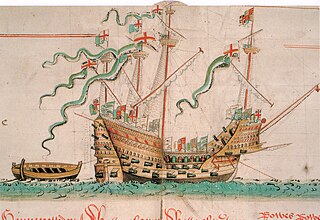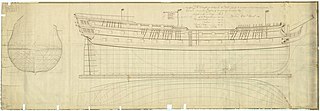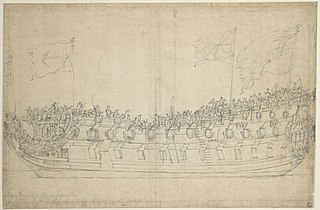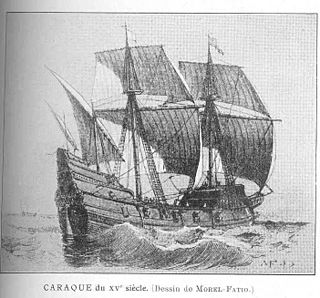Related Research Articles

The Mary Rose was a carrack in the English Tudor navy of King Henry VIII. She was launched in 1511 and served for 34 years in several wars against France, Scotland, and Brittany. After being substantially rebuilt in 1536, she saw her last action on 19 July 1545. She led the attack on the galleys of a French invasion fleet, but sank in the Solent, the strait north of the Isle of Wight.

HMS Colossus was a 74-gun third-rate ship of the line of the Royal Navy. She was launched at Gravesend on 4 April 1787 and lost on 10 December 1798. During her years of service she participated in the Battle of Groix, the Battle of Cape St Vincent, and the Battle of the Nile. While carrying wounded from the latter, she was wrecked at the Isles of Scilly. The wreck is a Protected Wreck managed by Historic England.
The Rooswijk was a ship belonging to the VOC that, according to recent, non-contemporary, news reports, sank in 1740. The wreck is a Protected Wreck managed by Historic England.

HMS Stirling Castle was a 70-gun third-rate built at Deptford Dockyard, in 1678/79. She was in active commission for the War of the English Succession, fighting in the Battles of Beachy Head and Barfleur. HMS Stirling Castle underwent a rebuild at Chatham Dockyard in 1699. She was in the Cadiz operation in 1702. The ship was wrecked on the Goodwin Sands off Deal on 27 November 1703. The remains are now a Protected Wreck managed by Historic England.

Hanover was a two-masted brigantine packet ship owned and operated by the Falmouth Post Office Packet Service, which operated between 1688 and 1852.
Cattewater Wreck is a wooden three-masted, skeleton-built vessel, one of many ships that have wrecked in Cattewater, Plymouth Sound, England. This wreck is close to the entrance of Sutton Harbour, its name is still unknown but it is believed to be from the 16th century. It is a Protected Wreck managed by Historic England.
The Wheel Wreck is the remains of a shipwreck lying in Crow sound off Little Ganinick in the Isles of Scilly. The wreck site consists of a discrete mound of cargo that appears to consist of numerous sizes of different iron wheels, cogs, clack valves, tubes and boiler pipes. Lead scupper pipes and other small artefact material show the ship was once present, however, not much remains of this vessel today. A Trotmann style anchor lies some 60m from the site, and this along with the cargo, date the site as sometime just after 1835. It has been published that this may be the wreck of the Padstow, however, being lost in 1804 this can not be so as neither boiler tubes or Trotmann anchors were invented back then. The wreck was discovered by local diver Todd Stevens in 2005 and investigated by the archaeological contractor for the Protection of Wrecks Act 1973 in 2006. It still remains unidentified. However it is most likely to be a ship called the 'Plenty' which is recorded locally as having sank- "within 1 mile of the principal island" -in 1840.
HMS Fowey was a fifth-rate warship of the Royal Navy, launched on 14 August 1744 in Hull, England. She spent only four years in commission before she struck a reef and sank in what is known today as Legare Anchorage in Biscayne National Park, off the coast of Florida. She was armed with six, nine, and eighteen pounder guns and crewed by more than 200 men.

San Esteban was a Spanish cargo ship that was wrecked in a storm in the Gulf of Mexico on what is now the Padre Island National Seashore in southern Texas on 29 April 1554.
The remains of an unknown wreck were discovered on Church Rocks, off Teignmouth in 1975. The site was designated under the Protection of Wrecks Act on 3 August 1977. The wreck is a Protected Wreck managed by Historic England.
The Bartholomew Ledges Wreck is a wreck found in the late 1970s at St Marys Sound, Isles of Scilly is believed to be that of a mid-sixteenth to early seventeenth century armed cargo vessel. The site was designated under the Protection of Wrecks Act on 23 September 1980. The wreck is a Protected Wreck managed by Historic England.
The Erme Estuary wreck is a shipwreck site containing the remains of potentially more than one wreck that was discovered in 1990 on Mary Reef in the Erme Estuary in Dorset. The site was designated under the Protection of Wrecks Act on 1 May 1991. The wreck is a Protected Wreck managed by Historic England.
The remains of an unknown armed cargo vessel dating to the sixteenth to seventeenth century were identified off Dunwich, Suffolk, England in 1993. The site was designated under the Protection of Wrecks Act on 12 July 1994. The wreck is a Protected Wreck managed by Historic England.
The Chesil Beach cannon consists of the remains of an unknown wreck were found on Chesil Beach, Dorset, England, in 2010. The site was designated on 18 July 2017. The wreck is a Protected Wreck managed by Historic England.
The remains of an apparent armed wooden sailing vessel were identified in 2010 on The Downs, Kent, England. The site was designated under the Protection of Wrecks Act on 3 August 2012. The wreck is a Protected Wreck managed by Historic England.

The remains of a late sixteenth or early seventeenth century carrack was discovered in Yarmouth Roads, Isle of Wight, England in 1984. The site was designated under the Protection of Wrecks Act on 9 April 1984. The wreck is a Protected Wreck managed by Historic England.
The Tearing Ledge Wreck consists of the remains of a ship, possibly one of the ships belonging to Admiral Cloudisley Shovell's fleet of 21 vessels returning from the Siege of Toulon via Gibraltar, that were found in 1969 on Tearing Ledge, Western Rocks, Isles of Scilly. The site was designated under the Protection of Wrecks Act on 12 February 1975. The wreck is a Protected Wreck managed by the National Heritage List for England.
The remains of a seventeenth century cargo vessel were identified in Gunwalloe fishing cove, Cornwall in 1998. The site was designated under the Protection of Wrecks Act on 23 May 1999. The wreck is a Protected Wreck managed by Historic England.

The Rill Cove Wreck is an underwater wreck of a 16th-century Spanish cargo ship lying off the coast of Rill Cove, west of Kynance Cove, in Cornwall, England, UK.
References
- 1 2 "GULL ROCK - 1000053 | Historic England". historicengland.org.uk. Retrieved 12 October 2020.